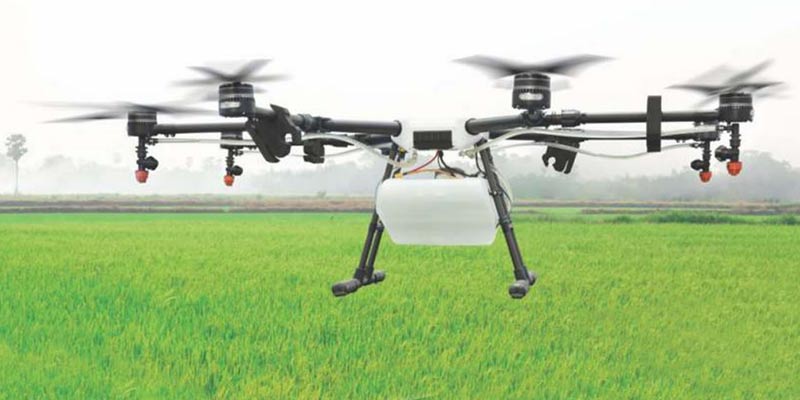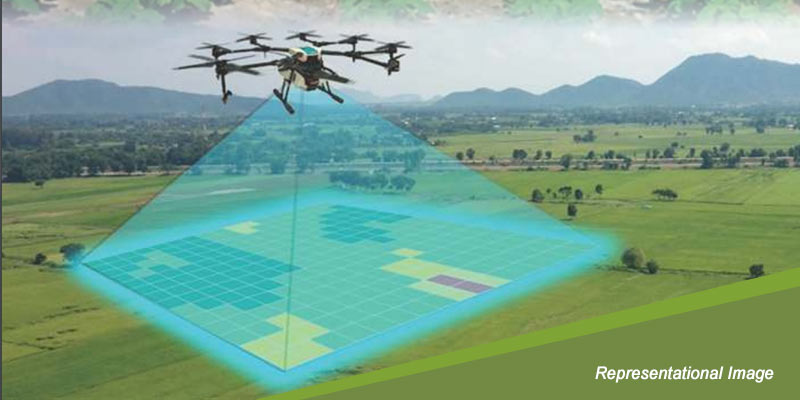- India
- Feb 21
How use of drones can be a game-changer in agri sector?
Prime Minister Narendra Modi flagged off 100 ‘Kisan Drones’ in different parts of the country for spraying pesticides and other farm materials.
The PM said a new culture of drone startups is getting ready in India. Their numbers will soon be in thousands from over 200 now, leading to the generation of employment opportunities on a massive scale.
This is a new chapter in providing modern farming facilities in the 21st century, and not only will it prove to be a milestone in the development of the drone sector but also open infinite possibilities, he said.
In the Budget Speech, Union Finance Minister Nirmala Sitharaman said that use of ‘Kisan Drones’ will be promoted for crop assessment, digitisation of land records, spraying of insecticides, and nutrients.
Adoption of drone technology in agriculture
• Indian agriculture has gone through rapid advancements and has benefited from research and adoption of new technologies by farmers. Technologies like drip irrigation, mechanised farming for planting, harvesting and grading are being successfully used for sustainable agriculture in India.
• In recent years, use of unmanned aerial vehicles (drones) have gained prominence and some states are actively engaged in checking the suitability of this new technology in agriculture.
• The adoption of modern technologies in agriculture, such as drones, have great potential to revolutionise Indian agriculture.
• Spraying of pesticides as well as soil and crop nutrients, monitoring and analysis of field moisture, fertigation, planting, harvesting, etc can be performed using drones.
• Drones are well-equipped with many features like multi-spectral and photo cameras and can be used in many areas such as monitoring crop stress, plant growth, predict yields, deliver props like herbicides, fertilizer and water.
• Drones can be used for assessing the health of any vegetation or crop, field areas inflicted by weeds, infections and pests and based on this assessment, the exact amounts of chemicals needed to fight these infestations can be applied thereby optimizing the overall cost for the farmer.
• Drone planting systems have also been developed by many startups which allow drones to shoot pods, their seeds and spray vital nutrients into the soil.
• This emerging technology can help the farmers in optimizing both the productivity and profitability of their land by reducing time, increasing the efficiencies of the inputs and securing high yield and quality of the crops.
• Drones are being considered as an essential tool for farmers for various applications now like providing easier ways to monitor small sections of crops and entire fields remotely and also address multiple challenges in the agriculture sector.
• Farmers face problems like unavailability or high cost of labours, health problems by coming in contact with chemicals (fertilizers, pesticides, etc) while applying them in the field, insect bites, etc. Drones can help farmers in avoiding these troubles in conjunction with the benefits of being a green technology.
• Conventional methods of pesticide spray application lead to excessive application of chemicals, lower spray uniformity, unnecessary deposition and non-uniform coverage, resulting in excessive usage, water and soil pollution as well as higher expenditure on pesticides.
• The use of drone technology is aimed at making production more efficient through precise spraying of pesticides and crop nutrients. This approach would not only ensure accuracy, uniformity in spray across the field, reduction in the overall use of chemicals within the area, but will also take care of the safety of the operators.
• Drone-based spray requires less amount of water, as well as pesticides, due to better application and bio-efficiency.
• The manned workload can be limited even further by aerial mapping feature of the drones.
• Maintenance of native soil fertility in the intensively cultivated regions of the country is one of the pre-conditions of maintaining and improving the current crop yield levels. The maintenance of soil nutrients is important to get higher productivity as well as production.
• Drones can be used for targeted input application, timely diagnosis of nutrient deficiency, crop health monitoring, rapid assessment of crop yield and crop losses. Crop nutrient spraying through drones facilitates rapid application and can be used to treat large areas quickly.
• Use of drones in agriculture has ample opportunities to provide employment to people in rural areas.
• The drone operations are being permitted by the ministry of civil aviation and Director General of Civil Aviation (DGCA) through the conditional exemption route. New drone directorates have been established in DGCA recently to speed up the approval process.
• In December 2021, Union Minister Narendra Singh Tomar released Standard Operating Procedures (SOPs) for use of drones in pesticide and nutrient application.
• The SOP for drone regulation for pesticide application covers important aspects like statutory provisions, flying permissions, area distance restrictions, weight classification, overcrowded areas restriction, drone registration, safety insurance, piloting certification, operation plan, air flight zones, weather conditions and emergency handling plan.
• The National Drone Policy has been notified and Drone Rules, 2021 have been made significantly easier for people and companies in the country to now own and operate drones. The requisite fees for permissions have also been reduced to nominal levels.
Additional read:
PLI scheme for drones, drone components
The Union government approved a production-linked incentive (PLI) scheme for drones and drone components with an allocation of Rs 120 crore spread over three financial years. The drones and drone components manufacturing industry may see an investment of over Rs 5,000 crore over the next three years.
Manorama Yearbook app is now available on Google Play Store and iOS App Store



